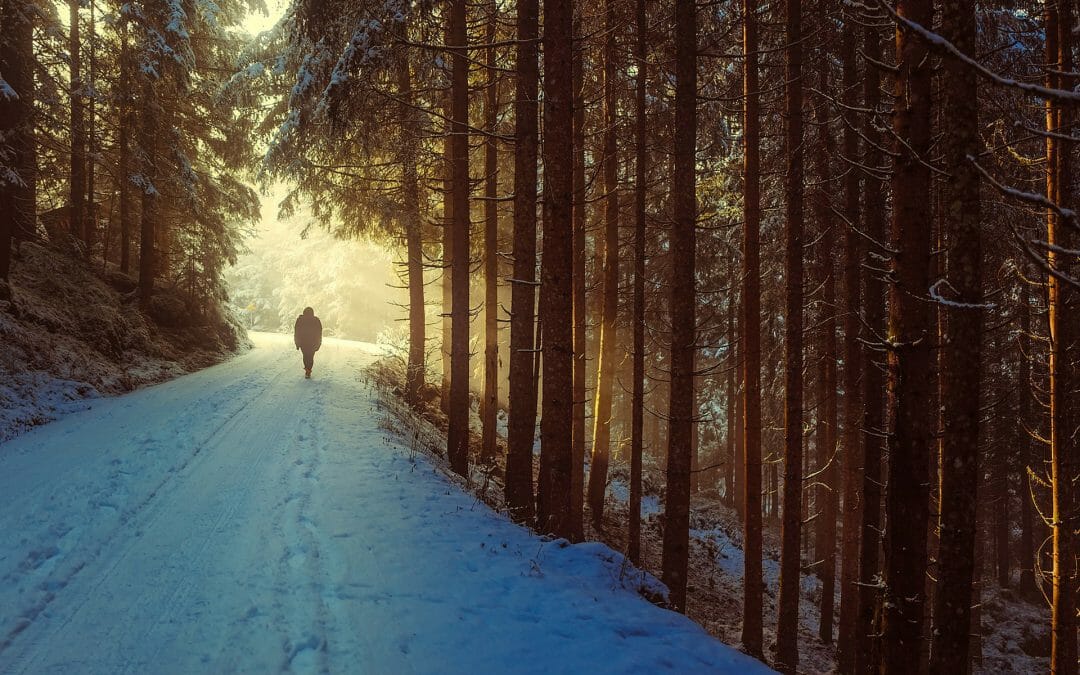Your holiday’s booked. You’re heading north. You’re keen to do some winter walking in Northumberland. What can you expect? One of my cottage guests, booked in for Christmas, asked if he’d need a 4×4 to get about and whether he’ll be likely to get snowed in. I explained that, in recent years, the chances of this happening over the holidays are increasingly rare: the best he might expect is some drizzle. But never say never! Who knows the effects of global warming? We’re seeing much hotter, drier summers. And we all remember the Beast From The East! Still, I think it’s fair to say that the Northumberland’s wintry blasts usually peak around February. Christmas and New Year are, more often than not, fine, bright and clear. Perfect weather for walking, in fact!
Miles to enjoy
There’s something special about walking in winter, isn’t there? A brisk walk outdoors leaves you feeling healthy and refreshed. When it’s frosty outside and the air is clear, views can be spectacular too. If you’re staying at one of our lovely lodges or log cabins in Felmoor Park or Bockenfield Country Park between now and February, then the opportunities for wonderful winter walks are countless. You’re very centrally placed in Northumberland at these locations, with easy access to all that is amazing about this county, including miles of walks in woodland, out on the hills and along the coast.
Is there a risk?
OK, OK, you’re just going out for a walk. Doesn’t matter what you wear, right? Wrong! One March, a couple of years ago, a woman was rescued after ascending Britain’s highest mountain, Ben Nevis, wearing summer clothes and carrying only a selfie stick. According to reports, 62% of casualties in the Scottish mountains were people deemed ‘experienced’, with ‘experienced males’ the most risk-taking group.
In the Lake District, 2017 was a record year for incidents. February was unusually busy, with many lower leg injuries (poor footwear was a contributory factor). Bad weather also adversely affected the number of people reported ‘lost’ and increased numbers of charity events meant people were venturing out without preparation.
It’s not just walkers that need help. Earlier this year, the North East Ambulance Service requested support from the Northumberland National Park Mountain Rescue Team to aid an injured cyclist at Kielder Water. So it’s important to be aware that even a short outing in an exposed wintry terrain carries an element of risk. However, that risk can be minimised if you just take a few sensible precautions before setting out.
Keep those extremities warm!
Keep your hands, head and feet warm, and you’ll lose less heat overall. Mitts are much better than gloves for keeping fingers warm (though you might find it hard to operate the camera!). A woolly hat under a fleece-lined hood is the most sensible headgear for a really chilly day, particularly in wind or rain. A head torch can be useful too, as nights often draw in sooner than expected.
Footwear
Well-fitting walking socks are essential to keep feet warm and prevent blisters. Gaiters help create a seal between boots and trousers, preventing snow from getting in. If you’re heading somewhere flat, with easy terrain and lots of puddles, wellies might be good enough; but a sound pair of walking boots offers better ankle support on rough ground. Don’t wear trainers! Many people find Nordic walking poles help them balance on uneven ground or on snow.
Outerwear
It’s important to think about the right layers when packing winter walking gear. Layered clothing is the key to staying warm: temperature can be regulated by adding or removing them. Opt for the types that wick sweat away from the skin (Merino wool-based ones are best, or those made of fleece fibres). If you work up a sweat but are wearing the wrong garments, you may overheat, clothing will get damp and you actually end up feeling colder. Avoid the wind-chill factor and risk of hypothermia with an outer jacket made of down, to keep the body toasty warm. Wear waterproofs, or a windproof shell made from breathable fabric, and carry an extra lightweight jacket or fleece in your bag. There are many good walking trousers available. One good option is to wear waterproof ones over a pair of Merino wool long johns. On no account wear denim jeans in exposed conditions – they absorb moisture and take a long time to dry.
Weather watch
Unless you’re walking in some of Northumberland’s more mountainous regions, you won’t have to worry too much, but do check the internet or local radio before you set off and study the forecast. Is there a chance of rain, sleet, snow, fog, ice? Remember, weather conditions can be localised, particularly in the hills. Have the sense to change your route if conditions are bad.
Plan for safety
Navigating a winter route can be challenging and daylight hours are limited. Terrain that was easy in summer can be a nightmare when ice and snow are around. If there’s low cloud too, the landscape can become blurred and should never be attempted in the dark. Let someone know where you’re going and what sort of time you expect to return. Your average walking speed will be slower in wintry conditions, so factor that in. Use a phone, compass or GPS to identify and avoid hazards. Always take an OS map with you. Above all, stay flexible and alter your route if need be. If you’re taking the kids and have a child’s buggy with you, stick to lower ground and easy terrain that has firm paths.
In Case of Emergency
Did you know a repeated series of six long flashes on a torch equals a request for help to a Mountain Rescue Team? Six long blasts on a whistle mean the same. Pack some First Aid essentials in your rucksack – just enough to self-treat any minor injuries. Remember your mobile phone, even if the signal is patchy. Many smartphones have GPS and useful map apps.
Fuel up
A winter walk will soon put an edge on your appetite. You burn more calories staying warm in winter, so take some sugary snacks to eat on the way. Take plenty of water with you, to avoid dehydration. Pack a thermos flask with something hot. You could even take a toasted sandwich (wrapped in tin foil, inside an insulated bag).
Watch out for wildlife
When trees are bare and birds are feeding, not breeding, you can spot some beautiful feathered friends, including migratory flocks, like redwing and fieldfare, as well as ducks, geese, swans and colourful wildfowl. Look for tracks of deer, badgers, foxes, otters. Keep quiet in the right places and you may even be rewarded with the sight of a red squirrel!
Respect the environment
Pack a plastic bag and take your rubbish away with you, otherwise, you endanger livestock and wildlife, and create an eyesore for other walkers. Close gates behind you and keep dogs on leads at all times. If you have a dog with you, take extra care not to enter a field with cows and calves. The cows may be protective and aggressive; and whilst your dog may outrun them, you will not.
Enjoyment for all the family
I hope this has whetted your appetite for adventure. Now you and the family are prepped and ready for a walk in the great outdoors, it’s time to think about the best places to go. Try the breathtaking walks in the National Park, across Hadrian’s Wall, the Coquet Valley, the Cheviot, Harthope Valley, the College Valley, Breamish Valley, Great Hetha, Hethpool and Yeavering Bell. There are wonderful woodlands to explore too, such as Thrunton Woods, Harwood Forest, Holystone, Wallington, Cragside, Edlingham, Swarland Wood, Bolam Lake Country Park, Kielder Water & Forest Park, and more besides. At many, you’ll find fantastic castles, stately homes and visitor attractions, but remember not everything is open in winter, so always check first before you set off.
By Terri Harper (25/11/2018)

